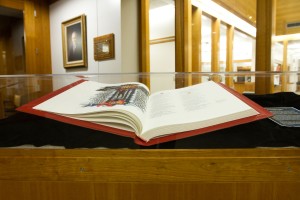
The staff of the L. Tom Perry Special Collections Library are working hard to keep up with the collection’s growing popularity.
The Special Collections Library in BYU’s Lee Library houses various historical items, from 19th-century Mormon manuscripts to antique film scores. The collection contains around 280,000 books and pamphlets, 8,000 manuscript collections and 500,000 photographs, among other odd items. Some of the most interesting items include six Academy Awards and even actor Jimmy Stewart’s accordion.
The Arts and Communications Archives collection is one of the library’s largest, attracting students and scholars alike from around the BYU campus and throughout the world. Curated by James D’Arc, the collection features more than 500 motion pictures and several original film scores, some of which were donated by the actors and directors themselves.
“When we show ‘It’s a Wonderful Life’ at Christmas time, that’s the film print that Jimmy Stewart gave us,” D’Arc said. “When we show ‘King Kong,’ that’s the film print that producer and director Marion C. Cooper donated to BYU.”
According to D’Arc, the “flagship” item of the Arts and Communications Archives is the Cecil B. Demille collection. The collection includes production and distribution files, casting and script files and photographs and files that fill 1,291 boxes.
“Since obtaining the Demille collection in 1977, we have had people come from nearly every country to use the collection for TV and DVD documentaries, master theses, doctoral dissertations and more,” D’Arc said.
Ryan Lee, the curator of the 19th-Century Mormon and Western Manuscripts Department hopes to bring students in despite its location on the bottom floor of the Harold B. Lee Library. “It isn’t the most ideal location for (the collection),” Lee said. “Hopefully we can drive students here anyway.”
The Special Collections library staff focuses on filling the halls with eclectic pieces of history, but they also work to integrate items into students’ curriculum. The staff currently collaborates with professors from different departments to create assignments that require students to access the collections.
According to Gordon Daines, the supervisor of Reference Services, more and more faculty are becoming aware of the library’s resources and how it benefits their course plans and the students they teach. One of the library’s goals is to make sure students know they have access to all resources and to give them a memorable experience. As word of the library’s hidden gem has spread, its usage has increased.
“As faculty realize what’s here in Special Collections, they’re more apt to send their classes here,” Daines said. “Then they talk to their colleagues, and their colleagues want to talk to somebody about Special Collections.”
The integration of Special Collections in the student curriculum has increased the curators’ workload, but it hasn’t stopped the library from undergoing an extensive digitization process.
Preserving antiquated content can be a challenge, as the Special Collections Library houses such a large number of items. To make sure that the collection’s documents, manuscripts and photos don’t deteriorate or undergo irreversible decay, proper care has to be maintained. Many of the items contained in the collection are old enough that the original copyright is no longer applicable, which means they can be turned into digital documents and published online.
Audio and video formats constantly change, and curators have to keep pace with the newest technology just to stay relevant. “As odd as it sounds, we’re continually chasing to keep up with the past,” D’Arc said. “We in archives have to keep up by migrating audio and video files to more stable formats — not only for preservation, but for patron use.”
As the content is digitized, more people are able to access and use it. According to D’Arc, after the content is published online, some will share it, which invites others to use it.
Emily Hansen, a freshman from Orem, works at the front desk of the Special Collections Library and said she feels lucky to be a part of the historical project. According to Hansen, one of her favorite parts of working at the library is the chance to interact every day with people who love what they do.
“There are a lot of stories and pieces of history in this space, and I feel lucky to be a small part of it,” Hansen said.
Though the curators and museum staff are as busy as ever, they love what they do. They want BYU students to know about it, and more importantly, they want students to use it.




